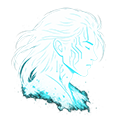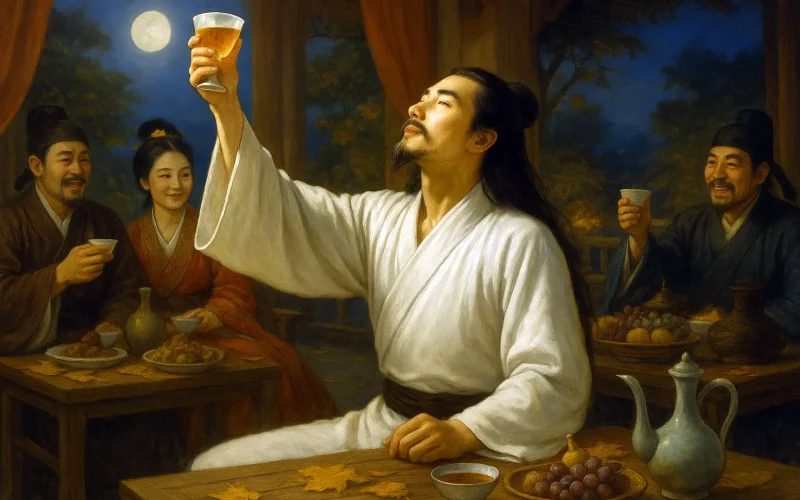A white horse with golden bridle, east by the Liaohai Sea;
Behind silken curtains, beneath an embroidered quilt, she lies in the spring wind.
The setting moon lowers by the eaves, peers through as the candle gutters;
Falling flowers drift past the door, laughing at the empty bed.
Original Poem
「春怨」
李白
白马金羁辽海东,罗帷绣被卧春风。
落月低轩窥烛尽,飞花入户笑床空。
Interpretation
This poem stands as a luminous pearl among Li Bai's "boudoir lament" verses, renowned for its exquisite contrasts and singular imagination. It captures with precision a specific psychological moment (the fading of a spring night) in a longing woman's experience. Through powerfully juxtaposed imagery and personification, the poet transforms intangible longing into palpable visual impact, showcasing Li Bai's exceptional skill in depicting subtle emotions.
First Couplet: "白马金羁辽海东,罗帷绣被卧春风。"
Báimǎ jīn jī Liáohǎi dōng, luó wéi xiù bèi wò chūnfēng.
His white steed with gold bridle battles east by Liaohai; I lie beneath silken quilts, alone in spring's warm breath.
The couplet's power lies in its vast spatial juxtaposition and extreme situational contrast. "White steed with gold bridle" presents a heroic, majestic image full of frontier spirit. "Silken quilts" evoke the inner chamber's luxury and tenderness. Yet this opulent environment ("lying in spring's breath") becomes profound irony and torment for the woman sleeping alone. The contrast between east (battlefield) and within (boudoir), between martial hardship and apparent comfort, instantly reveals the protagonist's inner conflict and pain.
Second Couplet: "落月低轩窥烛尽,飞花入户笑床空。"
Luò yuè dī xuān kuī zhú jǐn, fēi huā rù hù xiào chuáng kōng.
The setting moon peers through my window, watching the candle die; Blossoms drift indoors, mocking the empty bed's void.
This couplet deepens and elevates the emotion through microscopic focus and personification. The poet endows natural elements with spirit: the "setting moon" becomes an active agent that "peers," witnessing her sleepless night as the candle gutters, implying dawn approaches after a vigil. The "peering" moonlight creates a sense of exposed loneliness. "Blossoms mock the empty bed" is brutally brilliant—the romantic blossoms should symbolize vitality and joy but become cruel foils; their intrusion seems to ridicule the room's desolation. "Empty bed" lays bare the core of her sorrow with piercing directness.
Holistic Appreciation
The poem's structure is masterful. The first couplet establishes a horizontal contrast of circumstances, creating tension through spatial opposition; the second couplet achieves vertical deepening of psychological perception, focusing on temporal progression (the night's end) and detail. Not one character directly mentions "sorrow," yet lament permeates the verse. By combining seemingly unrelated images ("white steed" vs. "silken quilts," "setting moon" vs. "drifting blossoms"), Li Bai constructs a poetic world rich with internal conflict. The concluding "mock" character, using joyful scenery to convey sorrow, intensifies the grief exponentially, fully expressing the woman's ultimate loneliness—where even nature seems to mock her—creating a heart-rending artistic effect.
Artistic Merits
- Bold Imagery Juxtaposition: Directly contrasting the frontier's majestic imagery (white steed, gold bridle) with the boudoir's delicate imagery (silken quilts) creates immense aesthetic tension—a rare montage technique in classical Chinese poetry.
- Personified Emotional Projection: "Peer" and "mock" exemplify emotional transference. The poet projects the woman's sense of exposure and shame onto external objects, making the moon and blossoms mirrors and judges of her lonely soul, enhancing emotional penetration.
- Scene-Concluded Subtlety: The poem ends abruptly at the dynamic, meaningful scene of "mocking the empty bed," leaving the most intense emotion for the reader to contemplate, creating lasting resonance.
- Ultra-Condensed Language: Twenty-eight characters span space, time, character, circumstance, and emotion—each image meticulously refined, achieving remarkable artistic purity.
Insights
This poem reveals that true loneliness stems not from physical solitude but from severed emotional connections and lack of understanding. The woman's pain lies not only in her husband's absence but also in how her ardent longing clashes with her opulent yet hollow environment, where even the moon and blossoms become foils to her state. This reminds us that profound human emotions are often silent and private—unperceived by the world, even magnified by it. Simultaneously, the poem shows how individual emotional value (particularly women's feelings) appeared minuscule and helpless against grand social narratives (like war) in classical times, urging us to consider that every era should grant due respect and care to personal emotions.
About the poet

Li Bai (李白), 701 - 762 A.D., whose ancestral home was in Gansu, was preceded by Li Guang, a general of the Han Dynasty. Tang poetry is one of the brightest constellations in the history of Chinese literature, and one of the brightest stars is Li Bai.












